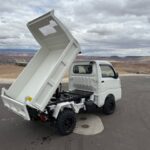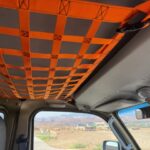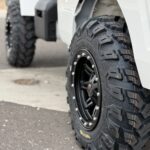

How to Protect Your Mini Truck from Rust and Corrosion
Mini trucks work hard in mud, rain, and snow. That exposure invites corrosion. If you want to protect mini truck from rust, start with a plan and stick to it. Consistent care preserves structure, safety, and resale value. It also lowers repair costs over time.
Know where rust starts
Rust loves trapped moisture and hidden seams. Focus on the frame rails, crossmembers, rocker panels, cab corners, and the bed floor. Check drain paths, spot-weld seams, and hardware. Examine mounts for racks, skid plates, and bumpers. Look for bubbling paint and orange dust. Catching it early saves money and time.
Wash smart, and wash often
Rinse mud and road salt fast. Dirt holds moisture against metal. Use a pressure washer with a fan tip. Aim at the frame, inner fenders, and bed supports. Don’t forget spring perches and leaf hangers. After winter driving, wash the undercarriage thoroughly. Dry the truck after washing, especially seams and pockets.
Undercoat the right way
A quality undercoating blocks moisture and abrasion. Use oil-based cavity wax in boxed sections and seams. Use rubberized or wax-based coatings on exposed steel. Mask brake rotors and exhaust before spraying. Reapply yearly if you drive on gravel or salted roads. Touch up any chips immediately.
Seal and protect the bed
Cargo beats up the bed floor. A spray-in bed liner seals scratches and prevents corrosion. It also reduces sliding and noise. If you prefer a removable solution, use a heavy rubber mat. Inspect under it often. Seal any exposed metal before reinstalling.
Maintain fasteners and hardware
Bolts and brackets corrode first. Replace rusty hardware with coated or stainless equivalents. Use anti-seize on threads exposed to spray. Check bed bolts, bumper mounts, and rack bases. A little prep keeps parts serviceable. It also makes future work easier.
Guard the underbody with armor
Undercarriage protection prevents impact damage that exposes bare steel. Fit skid plates under the engine, transmission, and transfer case. Consider a front bumper with recovery points. These parts take hits so your frame doesn’t. Touch up any scraped areas after hard use.
Keep water moving
Water must escape quickly. Clear drain holes in doors, sills, and bed channels. Flush them during washes. Check cowl drains below the windshield. Remove leaves and mud. Standing water is rust’s best friend. Don’t let it linger.
Address chips and scratches immediately
Bare metal flashes rust quickly. Clean the spot, then apply rust converter if needed. Prime and paint the area with matching touch-up. Finish with a clear coat. Keep a kit in the cab for fast fixes.
Store smart in every season
Park on concrete or gravel, not wet grass or dirt. Use a breathable cover if you store outdoors. Ventilate enclosed areas to limit humidity. After snow driving, rinse the undercarriage before parking overnight. Little habits make big differences.
Choose accessories that help, not hurt
Accessories can prevent or cause corrosion. Use racks with proper gaskets and sealant. Add mud flaps to cut spray on the frame. Consider fender liners to block debris. When mounting a winch or bumper, paint-drill holes and seal edges. Protect before you torque fasteners.
Build a simple maintenance cadence
Create a repeatable schedule.
- Weekly: quick rinse in bad weather.
- Monthly: undercarriage inspection and drain check.
- Seasonally: refresh undercoating and spot paint.
- Annually: deep clean, full inspection, and hardware audit.
Write it down. Track what you did and when you did it.
Model-specific considerations you can link later
Owners of Daihatsu Hijet Jumbo should watch extended-cab sill areas. Hijet HD Dump users should inspect dump hinge points and cylinder mounts. Hijet Deck Van owners should monitor rear deck seams and door drains. Link to parts or diagrams as needed.
Legal note
In the USA, kei trucks/mini trucks are generally classified as UTVs. Laws vary by state. Check whether your state allows UTVs on certain roads.
Keep your truck strong for years
Rust prevention is a habit, not a one-time task. With washing, undercoating, sealing, and smart storage, you’ll protect mini truck from rust and hold resale value. Add armor and quality hardware for extra insurance. If you want a tailored plan for your climate and roads, contact us today. We’ll help you protect mini truck from rust with the right products and cadence so you can work and explore confidently.
Add a comment Cancel reply
You must be logged in to post a comment.
Categories
Recent Posts
About us

Mini Monster Trucks
Blog Editor
Japanese Mini Trucks for sale in USA: We ship across the United States.
Popular Tags
4x4 mini trucks
best mini trucks
comparing mini truck models
Daihatsu Hijet comparison
depreciation of mini trucks
durable truck liners
how to sell mini truck
japanese mini trucks
Japanese mini trucks camping
kei truck
kei truck agriculture
Kei truck in the summer
kei trucks
mini monster trucks
mini truck
mini truck accessories
mini truck bumpers
mini truck buying guide
mini truck camping
mini truck farm use
mini truck for yard work
mini truck maintenance
mini truck maintenance tips
mini truck performance
mini truck protection
mini truck resale value
mini trucks for adventure
mini truck trade-in
mini truck upgrades
off-road farm truck
off-road mini truck gear
off-road mini trucks
off-road mini truck tires
off-road mini truck upgrades
off-road skid plates and bumpers
off-road summer truck
off-road utility vehicles
outdoor mini truck gear
resale value of mini trucks
rural trucks
skid plate benefits
spray-in bed liner
summer mini truck uses
truck accessories
truck bed protection
Related posts

January 5, 2026
Mini trucks are capable off-road performers that excel on narrow trails, rugged paths, forest roads, and rocky landscapes....

Mini Truck Work Uses: Practical Ways to Boost Productivity
McCann
December 22, 2025
Mini trucks have quickly become an essential tool for farms, job sites, ranch operations, and commercial properties across...

Mini Truck Storage Ideas for Better Organization and Efficiency
McCann
December 15, 2025
Mini trucks shine in versatility, but without proper organization, cargo can become cluttered, unsecured, or damaged. Using smart...

Mini Truck Lift Benefits: Why a Lift Kit Enhances Capability
McCann
December 8, 2025
Mini trucks already offer impressive off-road agility, but installing a well-designed lift kit elevates performance to an entirely...
Japanese Mini Trucks for sale in USA: We ship across the United States. Best UTV Side x Side on the Market. Mini Monsters is a Japanese mini truck dealership with a wide selection of quality, reliable mini trucks for sale. We have knowledgeable staff and offer financing, as well as maintenance and custom after market options for proud mini truck owners.





